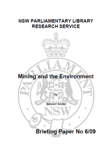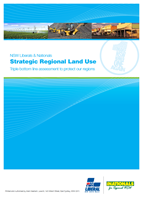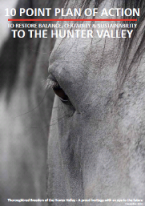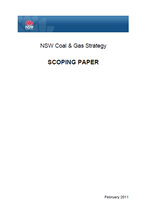[HOME]
GENERAL INFORMATION SOURCES/LINKS - Summary
1. Important Sources of Information / Fact Sheets
- NSW Farmers
NSW Farmers' Conservation and Resource Management (CRM) Committee and policy team strives to address the environmental and natural resource policy issues affecting the viability of farming in NSW. One of the key policy issues the Committee works on is mining, where it advocates for improved mining and planning legislation to achieve food and water security.
The Mining and Coal Seam Gas section of NSW Farmers' website includes some extremely helpful information, for example:
- Mining and CSG Information Sheet (August 2010)
- Mining Case Studies (February 2010)
- Mining Exploration and Land Access Agreements
The Association has developed a series of documents regarding mining exploration access to assist Members in developing Land Access Agreements with mineral explorers. Overview of Mining Exploration Access
Overview of Mining Exploration Access Developing Land Access Guidelines
Developing Land Access Guidelines Clauses for Consideration in a Land Access Agreement (REQUIRES LOGIN)
Clauses for Consideration in a Land Access Agreement (REQUIRES LOGIN)
The Framework includes a recommended pause on mining exploration and production licences, which would only apply to new applications for mineral and gas tenements; renewal applications; and extension of work programmes.
- Click here for a copy of the Framework document.
- Click here for a copy of a Briefing Note clarifying where the moratorium would and would not apply.
Coal and Gas Strategy Input
The NSW Farmers Association made an extensive submission to the NSW Government's Coal and Gas Strategy Scoping Paper. The Association has serious concerns about the Terms of Reference for the Strategy, and sections of the associated scoping paper. Specifically, the Association finds the Terms of Reference fail to adequately charge the Cabinet Subcommittee overseeing the process to consider the impacts of mining and gas development on agriculture. The Association is also concerned that the Strategy appears limited to only parts of the State and seeks to provide a plan for the mining and coal seam gas industries alone. This contrasts starkly with the planning framework proposed by the Association, which promotes statewide, upfront strategic planning as a tool to resolve the current conflict over mining in areas of productive agricultural land and water resources.
A copy of the Association's submission can be found here.
- NSW Parliamentary Library Research Service
A briefing paper for NSW politicians entitled 'Mining and the Environment' was produced in July, 2009 by the NSW Parliamentary Library Research Service. It is a very helpful, straightforward, 'just the facts ma'am' document detailing the 'state of play' in NSW regarding mining and the environment. It contains a lot of very useful information. Key headings from the table of contents include:
|
- NSW Department Of Primary Industries (DPI)
There is a LOT of information on the DPI's website regarding mining, and it can be a bit hard to navigate.
On top of this, things are currently in a state of flux. A series of amendments relating to environmental aspects of the NSW Mining Act (1992) were passed in the Mining Amendment Act (2008) BUT the majority of these amendments only came into effect when provisions of the new Mining Regulation 2010 came into force on November 15. (Even then, a number of important provisions in the Mining Amendment Act - particularly those regarding the environmental management and rehabilitation - won't come into force until further stakeholder consultation is completed.)
So - BE CAREFUL - when reading the information that's available from the DPI and other places. Depending on what you're reading, where it was sourced from and when it was dated, it may or may not still be true.
Listed below are a few key links likely to be of interest:
- The DPI website's Minerals And Petroleum home page
- Landholders' Rights - Common Questions
- Landholders' Rights - Access Arrangements And Compensation Under The Mining Act 1992 (Fairly detailed)
- TAS Map mapping application. (NB: Can be a bit fiddly to use.)
- Summary Guide Of Changes - Gives an overview of the changes that occurred and didn't occur on 15 November, 2010.
- Title Holdings (became effective on 15/11) which covers, amongst other things, changes to land access arrangements (whereby all access arrangements are now to be in writing and to be signed by all parties specified in the Act).
- Environmental Management (mostly proposed for commencement in 2011) covering changes to environmental protection and rehabilitation. (This section of the website also gives some information on how the changes will work in conjunction with the other two main pieces of legislation that regulate different aspects of the environmental impact of mining, namely the Environmental Planning And Assessment Act (1979) and the Protection Of The Environment Operations Act (1997). Critically, the EP&A Act definition of 'environment' will be adopted, broadening the application of the environmental provisions under the Mining Act 1992. This definition includes 'all aspects of the surroundings of humans, whether affecting a human as an individual or in his or her social groupings'. This means that a wider range of possible impacts can be addressed by mining title conditions.
- (Former) NSW Department of Infrastructure, Planning and Natural Resources (DIPNR)
The former NSW Department of Infrastructure, Planning and Natural Resources was replaced in August, 2006 by the NSW Department of Planning (DoP) and the NSW Department of Natural Resources (DNR). In 2007, the DNR was abolished and its functions transferred to what are now the Department of Environment, Climate Change and Water, the NSW Office of Water and the Department of Industry and Investment.
In 2005, DIPNR produced the document Management of stream/aquifer systems in coal mining developments. The guidelines provide for 40m setbacks in the case of underground mines to alluvial aquifers, and a 150m setback for an open cut mine. (This is very relevant in the case of Bylong and the Cockatoo Coal development. If these guidelines were applied strictly they could have a substantive impact on Cockatoo's potential operations and their viability/practicality.)
It's important to realise, however, that these are only guidelines and while they are part of negotiations with mines regarding their developments they are not absolutely mandatory. The report Coal Mining Potential in the Upper Hunter Valley - Strategic Assesment (2005) concluded that: 'A formal policy should be developed to avoid or minimise potential impacts of coal mining on major streams and aquifers in the Hunter Valley and elsewhere in the State. Along with this, guidelines should be developed for the assessment of coal mine impacts on streams and aquifers in seeking approvals under Part 3A of the EP&A Act.' Such a policy has not been developed. The Review noted that the application of such a policy would result in restricting coal mine development within or beneath the alluvium or alluvial aquifers of the Hunter River and its major tributaries. There has also been a deal of discussion in the media (e.g. this article) about the desirability of making the guidelines 'obligatory'.
- Environmental Defender's Office (EDO)
The Environmental Defender's Office (EDO) is a not-for-profit community legal centre specialising in public interest environmental law. It helps individuals and community groups who are working to protect the natural and built environment. The EDO receives financial assistance from the Public Purpose Fund of the Law Society of New South Wales, the Legal Aid Commission of New South Wales, the Commonwealth Attorney-General's Department, the (federal) Department of Agriculture, Fisheries and Forestry and the New South Wales Government through its Environmental Trust.
The EDO website has a Mining Factsheet that gives a concise overview of how mining (and petroleum) projects are assessed and approved, with a focus on the provisions which allow landowner and public participation. Note that the factsheet is currently in the process of being reviewed, in light of the pending introduction of the Mining Regulation 2010 (and the various Mining Amendment Act 2008 provisions that will come into force once the new Regulation becomes effective).
2. Information / Fact Sheets Produced By The Mining Industry
- NSW Minerals Council
The NSW Minerals Council (NSWMC) is the peak industry association representing the State’s $23 billion mining industry. NSWMC provides a single, united voice on behalf of its member companies which include mineral producers, operators, explorers and extractive material producers operating in NSW.
A couple of the more directly relevant links from their website are given below:
- The Mineral Exploration And You factsheet assists in understanding the laws relating to minerals exploration and mining titles and to explain how they can affect you and your property.
- The Mining And The Hunter Valley factsheet outlines the Mining Industry's views regarding how mining and other industries - such as agriculture and thoroughbred breeding - have 'coexisted (...) for generations and will continue to do so' in the Hunter.
- A number of other factsheets are also available, covering issues such as dust and noise, etc.
Upper Hunter Mining Dialogue / Stakeholder Report
The NSW coal industry established the Upper Hunter Mining Dialogue to get a better understanding of the collective impacts of the region's mines and to start a conversation with the community about developing solutions to some of the challenges.
In late 2010, the NSW Minerals Council commissioned the Australian Centre for Corporate Social Responsibility (ACCSR) to undertake a stakeholder survey, interviewing 93 stakeholders and decision makers from across the Upper Hunter to hear about the issues as they see them. The report from this stakeholder survey was released in April, 2011.
The key findings were:
- Stakeholders, including those from the mining industry, recognise that cumulative impacts from mining exist.
- Most stakeholders agree they need to work together to address the cumulative impacts of mining.
- There are different groups that do not always agree on what needs to be done. In some cases, they do not yet have strong enough relationships with one another to work together effectively.
- Bridging the divide between some groups will be a key challenge in developing solutions to the cumulative impacts of mining.
- Stakeholders have a relatively negative perception of the mining industry as a whole.
- Stakeholders rate relationships with individual companies or mines more favourably.
- Specific concerns most frequently raised in the research were about dust / air quality and employment opportunities and development.
A copy of the media release accompanying the report is available here, while the full report by the ACCSR is available here.
Coal and Gas Strategy Input
In making its submission to the Coal and Gas strategy, the NSW Minerals Council has said that the NSW Government must continue working with the community, industry and stakeholders as it develops the NSW Coal and Gas Strategy. This is necessary, according to the Council, to ensure that the future growth of the State’s coal mining industry, a cornerstone of the NSW economy, is appropriately managed.
A copy of the media release accompanying the Council's submission is available here, while the full submission is available here.
Coal and Gas Strategy Input
3. NSW State Election 2011
- 'Natural Advantage'
Six key environment groups in NSW (Nature Conservation Council, National Parks Association, Total Environment Centre, Wilderness Society, Blue Mountains Conservation Society, Colong Foundation) have gotten together to produce the document Natural Advantage, which they've described as 'a 2011 NSW state election agenda for safeguarding the benefits of nature'.
The document covers 10 key themes, one of which (#7) is 'Mining and Gas'. This section calls on all parties contesting the NSW 2011 election to commit to a number of key actions in this area, the first of which is 'Establish areas in NSW that are off limits to open cut and longwall mining and CSM extraction based on environmental, water supply and agricultural values'. Click here to view the document.
- 'Strategic Regional Land Use Policy' (NSW Liberals and Nationals)
The NSW Liberal and National parties released their long-awaited regional land use policy on 16th February.
The policy document outlines a "triple bottome line" approach to development, incorporating:
- Strategic land use planning to better understand the constraints to, and opportunities for growth;
- Reforms to the planning assessment process to improve monitoring, compliance and cumulative impact assessment;
- Reforms to mining and coal seam gas legislation to protect strategic agricultural land and associated water resources; and
- Tougher planning assessments while strategic land use plans and planning reforms are developed
To view a copy of the policy, click here, or on the image below.
To view the press release that accompanied the policy launch, click here.
- '10 Point Coal And Coal Seam Gas Plan' (NSW Labor)
The NSW Labor party released its 10 point Coal and Coal Seam Gas Plan on Tuesday, 15th March in a three page media release.
In summary, the plan's 10 points are:
- Ban exploration activities in waterways adjoining national parks and wind back exploration licences from other sensitive areas
- Ban the use of BTEX chemicals in coal seam gas operations
- Introduce exclusion zones to assist strategic land use planning
- Appoint three additional regional planning compliance officers to ensure industry best practice standards are maintained – bringing the number to six
- Conduct an audit of gas wells and drill sites across NSW to examine how operators have complied with conditions of approval for their exploration licences and operational wells
- Introduce new exploration protocols with increased minimum payments for exploration and production wells to guide coal seam gas industry practice regarding the use of farming lands
- Provide State guidelines to assist Councils negotiate contributions from mining companies
- Appoint a Coal and Gas Ombudsman to investigate and respond to complaints related to mining and exploration and extraction activities
- Ensure future approvals for gas pipelines are conditional on being located on public land corridors and Travelling Stock Routes to avoid agricultural land
- Establish new State Rehabilitation Awards to recognise excellence in returning mining lands to their natural state
To view a copy of the media release containing the policy - which includes a very small amount of additional information regarding the points outlined - click here.
- Hunter Valley Thoroughbred Breeders: '10 Point Plan Of Action'
The Thoroughbred Breeders of the Hunter Valley have released a Ten Point Plan of Action to end the land use conflict and restore balance to the Hunter Valley. In their plan, the breeders of the Hunter Valley call for a moratorium on all new exploration and mining decisions in the Hunter Valley pending an independent, comprehensive environmental and socio-economic assessment of the cumulative impact of mining on both the area and the thoroughbred industry.
The full plan document is available here.
In summary, the plan's 10 points are:
- Recognise the Hunter Valley's thoroughbred breeding industry - one of three International Centres of Thoroughbred Breeding Excellence in the world - as an industry of state significance.
- Protect Australia's internationally recognised thoroughbred breeding industry from permanent destruction by amendments to the SEPP to prohibit mining in the Hunter Valley where it directly threatens Thoroughbred Breeding operations.
- Develop a sustainable land use strategy for the hunter valley that: o protects productive agricultural industries and international Centres of Excellence, such as Thoroughbred Breeding in the Hunter Valley, in line with international best practice.
- Impose a moratorium - a sensible pause on new mining decisions in the Hunter Valley until a full, independent, cumulative environmental and socio economic impact assessment is undertaken on air and water quality, community health, visual amenity and the impacts on thoroughbred breeding in the Hunter Valley and a sustainable land use strategy is developed.
- Appoint a dedicated Minister for Agriculture who can represent agricultural issues in Cabinet without conflict or constraint.
- Establish an independent sustainable agriculture agency comprised of eminently qualified and respected individuals to report directly to the Premier and Agricuture Minister on all matters affecting the future sustainability of agricultural industries.
- Reform nsw mining, planning policies and laws subject to a pause or moratorium being instituted on new mining decisions until this reform process is concluded.
- establish an independent planning commission to assess, advise, monitor and enforce all mining applications and decisions and provide independant expert advice directly to the Premier and relevant Ministers.
- Respect and recognise landholder property rights by enacting State legislation to provide appropriate compensation to landholders affected by mining operations.
- Stop the sterilisation of productive agricultural land and end the land use conflict in nsw by implementing policies and laws to protect Australia's premier Thoroughbred Breeding Industry.
4. NSW Coal And Gas Strategy
- NSW Department of Planning
On 2nd February, 2011, the NSW Government released a scoping paper seeking input from the public and key stakeholder groups to guide the preparation of a NSW Coal and Gas Strategy.
Preparation of the Coal and Gas Strategy is being led by the Department of Planning, with assistance from all key government agencies including Treasury, NSW Health, the Department of Environment, Climate Change and Water and Industry and Investment NSW. A stakeholder reference group has also been established to assist in developing the strategy, comprising representatives a range of bodies, including mining-related councils, the Total Environment Centre, the NSW Minerals Council Australian Petroleum Production and Exploration Association, the NSW Farmers Association, the Construction, Forestry, Mining and Energy Union and the Nature Conservation Council of NSW.
Written submissions closed on 15th April, 2011.
To view the scoping paper document, click here (or click the image below).
To view the terms of reference for the Coal and Gas Strategy, click here. Further information, including a summary of key issues raised at the various forums, is available on this page of the Departmehnt of Planning's website.
There was also an online discussion forum where people could express their views regarding what should be considered in the strategy. While this forum is now closed, the comments made are still viewable.
- Local Community Group (and Other) Submissions
While it is understood that most submissions made to the Strategy Scoping Paper will eventually be made available on the DoP website, a number of submissions by local (Hunter/Central West) groups and individuals - and from other areas - have been collated here for easy reference.
- Bylong Valley Protection Alliance
- Mid-Western Regional Council
- Rylstone District Environment Society
- Mid-Western Community Action Network
- Singleton Shire Healthy Environment Group
- Hunter Valley Water Users Association
- Hunter Central Rivers Catchment Management Authority
- NSW Farmers Association
- NSW Minerals Council
- Lithgow Environment Group
- Southern Highlands Coal Action Group
- National Trust
- Julia Imrie
- Bruce Russell
- Carol Russell
5. Coal And Health
- Dr Dick van Steenis
Dr Dick van Steenis, from the UK, visited Australian recently, speaking at a Coal and Health forum in Sydney and at various locations around the Hunter and Mudgee regions during March. Dr van Steenis has a particular interest in industrial pollution, including the impacts of coal mining and power generation on health.
A comprehensive bibliography of references (around 360 in total, updated Jan 2011) can be viewed here, while a transcript of the talk he gave in Mudgee is available here.
[HOME]





